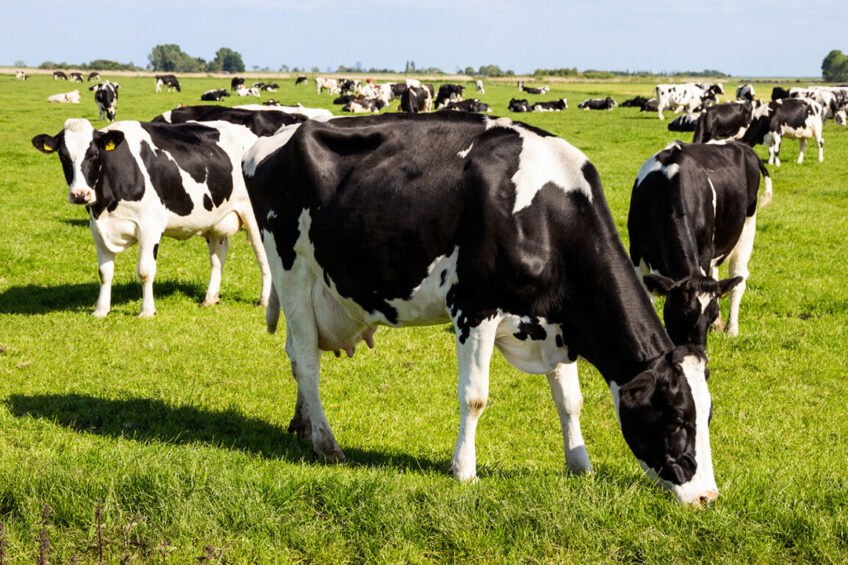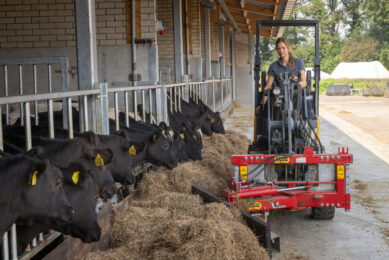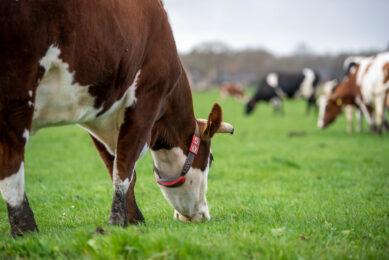Mob grazing for dairy – Can tall grass boost forage?

On-farm research is looking to see whether tall-grass grazing can boost forage fields while maintaining milk production and supporting nature and soil health.
Dairy farmers have teamed up with researchers to test the practice on both milking cows and some youngstock and dry cows to find out if mob grazing can add value to a dairy business.
The concept mimics the natural grazing behaviour of wild ruminants in large herds, which intensively graze in one area and then move on. The stock grazes on the basis that a third of the forage is available to feed the cows, a third is trampled to feed the soil and the final third is left so the plant can regrow more rapidly. Cows are moved on frequently to prevent over-grazing.
Applying this method to grazing systems by controlling where cattle graze can allow the grass to grow up to 50% taller, meaning seed heads can develop and root structures are stronger, which boosts soil health and biodiversity.
Debbie Wilkins farms a 900-acre mixed conventional farm on a floodplain in the Severn Vale, UK, with dairy, beef and arable. She said: “I’ve heard mob grazing works well on brittle environments, which is not what we have here in the Severn Vale, so I am really keen to see how it works on my farm.”
Enough nutrition
“After our first weighing, the tall, stemmy grass is giving similar growth rates of 0.8kg/day to the conventionally grazed grass. Time will tell if there is enough nutrition to have good growth rates all season. There is a lot to discover and manage and it will be interesting to see how it progresses,” said Wilkins.
Wilkins is grazing weaned to 12-month-old calves in the trial, in 2 groups on daily moves. Half are on grass leys sown with grasses and herds that cope with flooding, and the other half are on permanent pasture flood meadows. The tall grass groups are going in at high covers of 6,000+ kg/dry matter on plate meter, and she says it is getting quite a lot of trampling which helps add organic matter to the soil.
Tom and Sophie Gregory are also members of the Innovative Farmers trial and have been battling with underperforming fields on their 900-acre, organic dairy unit in Dorset, UK. They form a block calving system of 360 cows and are determined to utilise all their fields while minimising their use of organic fertilisers and supporting better biodiversity and water quality, but without risking their herd yields.
They feel there could be animal health benefits: “As the animals will move on at a faster rate, there should be less exposure to fluke and worm eggs. And we should minimise the risk of underfeeding as they will be eating what they need – resulting in optimum health and performance.”
Soil health
The trial also aims to test and research improvements in soil health, particularly improving the balance of bacteria and fungi to increase nutrient availability in fields. As a result, farmers are carrying out periodic soil samples with support from Harper Adams University. Spokeswoman Sarah Morgan, who is backing the 3 year trial, said she was hoping to see that all grass can be used as a tool by dairy farmers to improve soil health and functionality: “I’m excited to learn more about how grazing management effects soil bacteria and fungi in particular.”
One farm is also working with Foyle Food Group to look at growth rates of cattle, weekly calf worm counts, dung beetles and brix measurements. The aim is to see if paddock-style grazing reduces the need for wormers and if the diverse herbal seeds mix is better than typical grass-clover pasture.
Rebecca Swinn, Innovative Farmers manager, said: “Field labs are a great way to test on-farm ideas. They provide a framework for research and technical data which can be a stumbling block preventing farmers from testing their own theories. Bringing farmers together means the benefits also stretch far beyond just 1 farm.
“Tall-grass grazing is a practice utilised by beef and sheep farmers but less so in the dairy sector due to the need for a consistent supply of high-quality forage in the diet. The field lab will test the premise that you can successfully integrate tall-grass grazing into dairy farming as a means of improving the soil health of poorer fields.”
Join 13,000+ subscribers
Subscribe to our newsletter to stay updated about all the need-to-know content in the dairy sector, two times a week.










